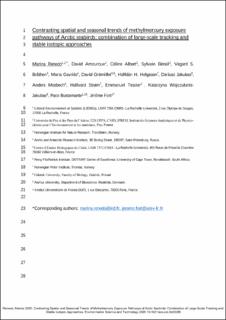Contrasting Spatial and Seasonal Trends of Methylmercury Exposure Pathways of Arctic Seabirds: Combination of Large-Scale Tracking and Stable Isotopic Approaches
Renedo, Marina; Amouroux, David; Albert, Céline; Bérail, Sylvain; Bråthen, Vegard Sandøy; Gavrilo, Maria; Grémillet, David; Helgason, Hálfdán H.; Jakubas, Dariusz; Mosbech, Anders; Strøm, Hallvard; Tessier, Emmanuel; Wojczulanis-Jakubas, Katarzyna; Bustamante, Paco; Fort, Jérôme
Peer reviewed, Journal article
Accepted version

Åpne
Permanent lenke
https://hdl.handle.net/11250/2686722Utgivelsesdato
2020Metadata
Vis full innførselSamlinger
- Publikasjoner fra CRIStin - NINA [2364]
- Scientific publications [1392]
Originalversjon
10.1021/acs.est.0c03285Sammendrag
Despite the limited direct anthropogenic mercury (Hg) inputs in the circumpolar Arctic, elevated concentrations of methylmercury (MeHg) are accumulated in Arctic marine biota. However, the MeHg production and bioaccumulation pathways in these ecosystems have not been completely unraveled. We measured Hg concentrations and stable isotope ratios of Hg, carbon, and nitrogen in the feathers and blood of geolocator-tracked little auk Alle alle from five Arctic breeding colonies. The wide-range spatial mobility and tissue-specific Hg integration times of this planktivorous seabird allowed the exploration of their spatial (wintering quarters/breeding grounds) and seasonal (nonbreeding/breeding periods) MeHg exposures. An east-to-west increase of head feather Hg concentrations (1.74–3.48 μg·g–1) was accompanied by significant spatial trends of Hg isotope (particularly Δ199Hg: 0.96–1.13‰) and carbon isotope (δ13C: −20.6 to −19.4‰) ratios. These trends suggest a distinct mixing/proportion of MeHg sources between western North Atlantic and eastern Arctic regions. Higher Δ199Hg values (+0.4‰) in northern colonies indicate an accumulation of more photochemically impacted MeHg, supporting shallow MeHg production and bioaccumulation in high Arctic waters. The combination of seabird tissue isotopic analysis and spatial tracking helps in tracing the MeHg sources at various spatio-temporal scales.